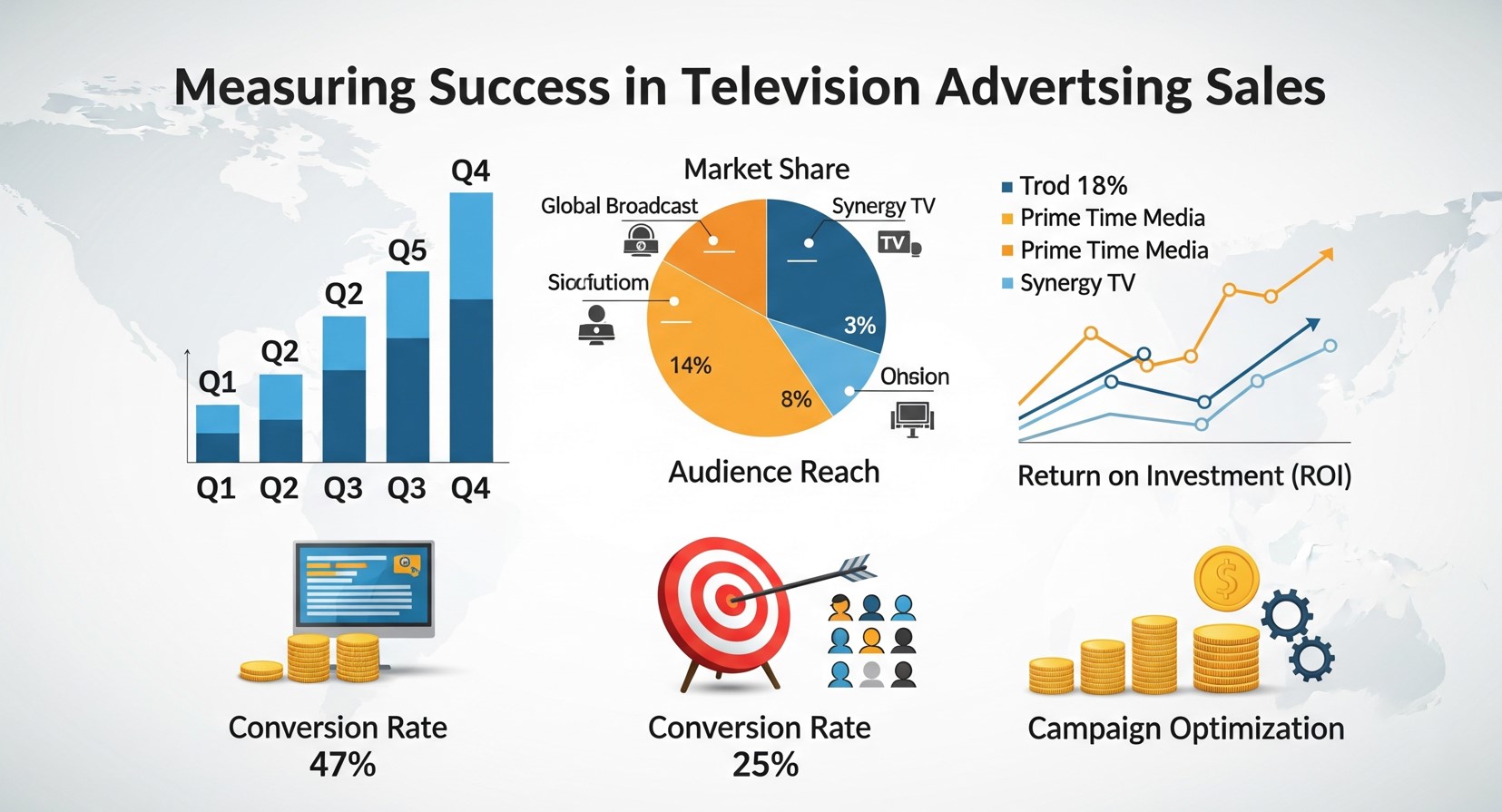Television advertising remains one of the most powerful ways to reach large audiences, even as digital platforms continue to evolve. But behind every commercial you see during your favorite show lies a complex sales process that connects brands with television networks and stations.
Television advertising sales is the business of selling commercial airtime to advertisers who want to promote their products or services to TV viewers. This process involves media sales professionals who work for television networks, local stations, or advertising agencies to negotiate deals, secure placements, and maximize revenue from available commercial inventory.
Understanding how television advertising sales works can help both advertisers make smarter media buying decisions and professionals considering a career in this dynamic field. This guide will walk you through everything you need to know about the television advertising sales process, from key players to pricing strategies.
How Television Advertising Sales Works
The television advertising sales process begins with inventory management. TV stations and networks have a limited amount of commercial time available during each program, typically ranging from 8-16 minutes per hour depending on the time slot and type of programming.
Sales teams organize this inventory by daypart (time periods like prime time, daytime, or late night), audience demographics, and program genres. They then create rate cards that outline pricing for different time slots, though actual rates are often negotiated based on factors like advertiser demand, seasonal fluctuations, and available inventory.
Media buyers representing advertisers or agencies contact sales representatives to discuss their client’s needs, including target audience, budget, campaign timeline, and specific programming preferences. The sales rep then proposes available inventory that matches these requirements.
Negotiations typically focus on cost per thousand impressions (CPM), total budget allocation, and added value opportunities like sponsorships or promotional tie-ins. Once terms are agreed upon, the advertiser commits to a flight schedule outlining when their commercials will air.
Key Players in Television Advertising Sales
Several different types of professionals work within the television advertising ecosystem:

National Sales Representatives work for major networks like ABC, NBC, CBS, or Fox to sell advertising across their entire programming lineup. They typically handle large national campaigns with budgets in the millions.
Local Sales Representatives work for individual TV stations in specific markets, selling airtime to local and regional businesses. They focus on building relationships within their geographic area and understanding local market conditions.
Agency Media Buyers work for advertising agencies and represent multiple clients. They negotiate rates and placements across different stations and networks to create comprehensive media plans.
Traffic Coordinators manage the scheduling and execution of commercial placements once deals are finalized, ensuring ads run at the correct times and tracking any makegoods needed for missed spots.
Television Advertising Pricing Models
Television advertising uses several pricing structures depending on the type of buy and advertiser needs:
Fixed pricing involves purchasing specific time slots at predetermined rates. This gives advertisers certainty about when their ads will run but typically costs more than flexible options.
Preemptible pricing offers lower rates in exchange for the possibility that higher-paying advertisers could bump your commercial to a different time slot. This option works well for advertisers with flexible scheduling requirements.
Scatter buying refers to purchasing available inventory closer to air dates, often at premium rates due to reduced availability. This contrasts with upfront buying, where advertisers commit to annual schedules months in advance for better rates.
Sponsorship packages bundle commercial time with additional promotional opportunities like on-screen graphics, program mentions, or digital tie-ins for a comprehensive marketing approach.
The Role of Ratings and Demographics
Television advertising sales heavily relies on audience measurement data provided by companies like Nielsen. These ratings determine how many people watched specific programs and provide detailed demographic breakdowns by age, gender, income, and other characteristics.
Sales representatives use this data to demonstrate the value of their inventory to potential advertisers. A program that attracts 2 million viewers aged 25-54 with household incomes over $50,000 will command higher rates than a show with the same total viewership but different demographics.
Advertisers pay particular attention to their target demographic’s viewing habits when making buying decisions. A luxury car manufacturer might prioritize programs that attract affluent viewers, while a toy company focuses on family-friendly programming during times when children are watching.

Digital Integration and Modern Challenges
Television advertising sales has evolved significantly with the rise of streaming services, DVRs, and on-demand viewing. Many traditional broadcasters now offer multiplatform packages that include their digital properties alongside linear TV inventory.
Addressable advertising technology allows for more targeted commercial delivery, even on traditional television broadcasts. This capability enables advertisers to show different commercials to different households watching the same program based on demographic or behavioral data.
Programmatic buying platforms have also entered the television space, automating some aspects of the buying and selling process that were previously handled entirely through direct negotiations between sales reps and media buyers.
Career Opportunities in Television Advertising Sales
Television advertising sales offers various career paths for people with strong communication skills and business acumen. Entry-level positions often include sales coordinator or account coordinator roles that provide exposure to client management and campaign execution.
Successful professionals can advance to account executive positions, where they manage their own client portfolios and have revenue targets. Senior roles include sales managers who oversee teams and national sales directors who handle major client relationships.
The field requires strong analytical skills to interpret ratings data and market trends, excellent presentation abilities for client pitches, and relationship-building skills to maintain long-term partnerships with advertisers and agencies.
Measuring Success in Television Advertising Sales
Television advertising campaigns are typically evaluated using several metrics beyond just viewership numbers. Reach measures how many different people saw the advertisement, while frequency tracks how often the average viewer was exposed to the message.
Brand lift studies examine whether advertising exposure led to increased awareness, consideration, or purchase intent among target audiences. Sales attribution analysis attempts to connect television advertising exposure to actual consumer behavior and revenue generation.
Television advertising sales professionals track their performance through revenue generation, client retention rates, and market share growth within their assigned territories or client categories.

The Future of Television Advertising Sales
Connected TV and streaming platforms are reshaping how television advertising is bought and sold. These platforms offer more precise targeting capabilities and detailed performance measurement, similar to digital advertising channels.
Artificial intelligence and machine learning tools are beginning to optimize media planning and buying decisions, helping sales professionals identify the most effective inventory for specific advertiser goals.
Despite these technological advances, relationship-building and strategic consultation remain central to television advertising sales success. Clients value sales representatives who understand their business objectives and can recommend comprehensive solutions across different media channels.
Getting Started with Television Advertising
Whether you’re an advertiser considering television or someone interested in a sales career, understanding the fundamental principles of television advertising sales provides a strong foundation. The industry continues to evolve, but the core concept of connecting brands with audiences through compelling video content remains constant.
Television advertising sales combines analytical thinking with creative problem-solving, making it an attractive field for professionals who enjoy working with data while building meaningful business relationships. As viewing habits continue to fragment across different platforms and devices, skilled sales professionals who can navigate this complexity will remain in high demand.
The television advertising landscape offers opportunities for both large national campaigns and targeted local efforts, providing multiple entry points for businesses of different sizes and sales professionals at various career stages.





